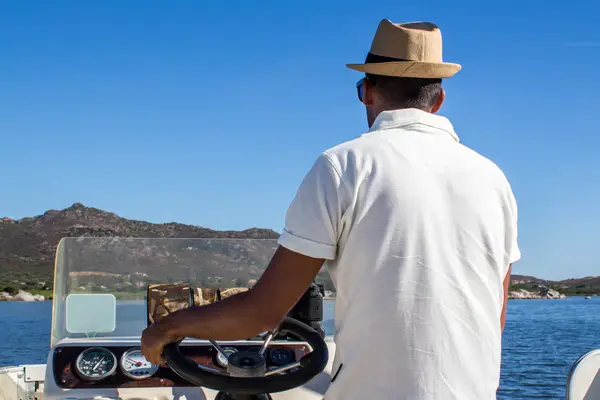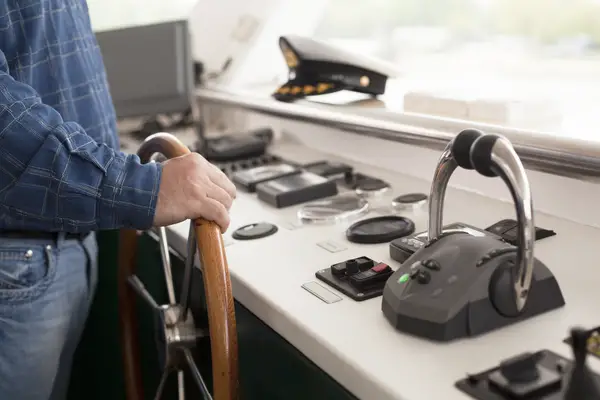Driving a boat is a fun and rewarding experience, but some are not as easy as others to operate. You may be wondering, how hard is it to drive a boat?
The difficulty level of operating a boat may vary based on the vessel and body of water. Novices love center console boats, pontoons, and Jon boats for their ease of use and steering characteristics in calm waters.
Plenty of other factors will affect the difficulty of operating the boat such as wind, how much room you have to move around, and the body of water you are in (rough ocean, calm lake, or bays).
With all of this in mind, how hard is it to drive a boat on average? And what boats are the best to drive?
Table of Contents
- What is it Like to Drive a Boat?
- Is Driving a Boat Similar to Driving a Car?
- Is the Difficulty of Driving a Boat Dependent on the Type of Vessel?
- What are the Basic Rules of Boating?
- How to Learn to Drive a Boat?
- Conclusion
What is it Like to Drive a Boat?
Driving a boat can be challenging for those who have never done it before, but it is not necessarily tricky. You should take into account time and practice to get used to the controls and handling of the boat.

With proper training and experience, driving a boat can become second nature. Remember, you need to allow yourself plenty of time and patience to learn the basics.
Physical Demands
Driving a boat does require some physical effort, mainly when steering and navigating rough waters or tight spaces. Boats are not going to be able to stop on a dime, so planning certain maneuvers or actions will be needed.
However, modern boats often come equipped with power steering and other assistive features that can make the process easier.
You will need to physically be able to tie a line to keep your boat secure at a dock. If you are unable to do so, you will risk losing your boat when you are docking.
Size and Space
Driving a boat in wide open spaces is relatively a straightforward process, but the challenges increase as the surroundings become more confined.
This is especially true when attempting to dock the vessel, which requires precise maneuvering.
Additionally, larger boats tend to be more complex to operate, requiring the operator to be proficient in using systems such as sonar and GPS.
In contrast, driving a boat is generally easier than handling a car of similar size due to the lack of obstacles in the water.
On top of these differences, there are many differences between boats of the same size, so you have a lot of variation when choosing!
Mental Demands
Driving a boat requires mental concentration and attention to detail. You must be aware of your surroundings, other boats or objects in the water, and any local laws and regulations.
It is also essential to pay attention to weather conditions and adjust your speed and course accordingly. Learn how the wind affects navigation and the movement of water in order to successfully travel.
Technical Knowledge
To safely operate a boat, it is crucial to have a basic understanding of the mechanics and systems of the vessel.
This may include engine knowledge, fuel and electrical systems, and navigation equipment. Some basic knowledge of first aid and emergency procedures is also recommended.
It is also beneficial to understand certain terminology and parts of the boat. Running lights, for example, are important to safely identify the direction of a boat. These are terms such as:
- Bow (front)
- Stern (back)
- Port (left side with red light)
- Starboard (right side with green light)
Experience and Training
While driving a boat is not necessarily difficult, you should have proper training and experience before attempting to operate a vessel.
Most states require boat operators to have a boating license or certification, which can be obtained through a boating safety course or another training program.
Having some hands-on experience operating a boat is also recommended before attempting to take it out on the water.
Is Driving a Boat Similar to Driving a Car?

There are moments when driving a boat is much more complicated than driving a car. However, do not let this deter you from enjoying the moment; it should be a relaxing experience.
In most states in the US, boaters are required to have a safety certificate or boating education class before being able to drive a boat legally.
While this sounds similar to driving a car for the first time, it differs in a variety of ways.
Traffic
Most adults have a vehicle or ride in something on their way to work, school, or wherever they need to go. This creates a lot of traffic, especially in bigger cities.
For boats, you will likely not see much traffic compared to driving a car, but you still need to be aware of your fellow boat drivers.
Depending on the time of year, such as holidays, fishing tournaments, or just nice days outside, a lot of people could be on the water at once.
Speed Bumps
Some places use speed bumps to slow car drivers down. When using a boat, you can think of nature’s speed bumps as rocks, sandbars, and reefs.
When driving a boat, you need to be aware of your surroundings and depth to ensure you do not strike anything. You also need to be careful when driving bear bridges and attempting to dock your boat.
Location of Driving
There are some big differences between driving a boat in calm waters and offshore. In calm waters, you are able to make mistakes and not affect how the boat moves by just a slight movement.
In rougher waters, you will need to be more precise in your actions to make the boat behave.
Boating Is Intimidating
Some new car drivers, typically teenagers, are nervous about their driving. This intimidating feeling will not go away until you develop the proper skills and experience.
While driving a boat, those same feelings could also be present. Slowing down, for example, is a skill you will need to learn.
Simply removing your foot from the pedal will not be all you have to do, as you also need to pull back on the throttle.
Is the Difficulty of Driving a Boat Dependent on the Type of Vessel?
Each boat you step foot on will require a little bit of time to become familiar with in order to operate properly. If you are new to boating, you might be wondering how difficult it is to operate smaller vessels on calm, fresh water.
The good news is that it is actually quite simple, as all you need to focus on is the throttle and steering. Do not be intimidated by operating a boat for the first time.
After a few minutes of driving, you will likely feel quite comfortable. Of course, it may take a bit of practice to master docking the boat, but overall, operating these boats on calm water is a breeze.
Smaller Boats
Smaller boats, ones under 30 feet, will be much easier to drive. Your average fishing boat will likely cater to first-time users and those that want a simplistic approach to driving on the water. Some examples of these boats include:
- Center console
- Bowrider
- Bass boats
- Bay boats
- Ski boats
- Deck boats
- Jon boats
- Dinghies
- Pontoons
Larger Boats

While smaller pleasure boats may be more manageable, operating a larger boat (over 30 feet) like convertibles, yachts, or express boats for offshore fishing can be a significant challenge, particularly when sailing on the open sea.
These vessels are much larger and come with many complex systems that must be navigated, such as electronic navigation systems that provide crucial information about location and water depth.
In addition to steering and controlling the throttle, operating a larger boat requires a high level of attention and technical knowledge.
These are typically more expensive pieces of equipment, so you want to ensure you have thorough knowledge before operating.
Sailboats
To be a successful sailor, one must possess three core skills. The first is the ability to determine the direction of the wind.
The second is the capacity to steer the sailboat accurately. Lastly, it is important to assess if the sail is properly trimmed.
These skills sound easy on paper but require some training and practice to handle efficiently.
If you are expecting to learn how to drive a sailboat after a few minutes, you should consider something much easier and less time-consuming like a Jon boat.
What are the Basic Rules of Boating?
Assuming you are a good driver with a vehicle, you likely have manners and principles that you follow. The same applies to boating, as there are rules that every boater should know.
- Limit your speed
- Be aware of other boaters
- Be respectful
- Be safe (change course when it makes sense)
- Avoid being too close to government boats and restricted areas
How to Learn to Drive a Boat?
The best way to learn how to drive a boat is to operate one physically. You will either need a friend that has one or consider boating lessons from a qualified professional.
If you are aiming for a boating license to steer for a company or for a charter, that is a slightly different process.
If you plan to learn on your own, you should look into boater safety courses online. Even if you do not plan to use some of the boats mentioned, it is great knowledge overall to drive a boat safely.
If you can drive a boat to practice, like a bowrider or cuddy cabin, here are the basics to try when driving.
Understanding the Power Source
Before starting your boat, it is crucial to clear any potential fumes by engaging the blower in the engine compartment.
Starting the engine is fairly straightforward, as you put the key wherever the ignition is or press the start button (if equipped).
If the boat is equipped with a kill switch on the dash, it is wise to attach that lanyard to your life jacket before taking off if you are thrown overboard.
This way, you can safely retrieve your boat and stop the propeller from turning.
Gear, Lines, and Throttle
Ensure all passengers and gear (such as sunglasses, proper shoes, and first-aid kit) are onboard and all lines are removed from the dock. To set the boat in motion, push the throttle forward or press down until it moves into gear.
Steering Wheel and Trim
You will need to adjust the steering by the wheel so that you can determine the direction of travel, and adjust the throttle to accommodate the speed you want.
The boat will need to be trimmed for the best performance in various conditions, so understanding this feature will take some practice as well.
If you want to slow down, there are no brakes. But do not worry, push down gently on the throttle towards neutral and hold it there for a few seconds.
After those few seconds, engage in reverse to push the boat away from the momentum of moving forward.
Steering Wheel vs Tiller
As mentioned, a wheel is pretty straightforward in determining your direction and is more comfortable to use. But, it does take a moment for the boat to respond in rougher conditions.
With a tiller, it requires some strength to push in tough conditions and a bit of an awkward adjustment if you have to turn sideways in your seat to mess with it often.
Boaters often say that a tiller, like in a Jon boat, lets you feel exactly how the boat is going to react with the wind and water flow. It responds much faster than turning a wheel so you can have a better reaction time at turning your boat.
Conclusion
As you can see, it is not that hard to drive a boat if you are in the right conditions, and the boat is manageable for beginners. It is best to have some boat safety and to remain positive before operating a boat.

Growing up in Florida, I’ve been surrounded by saltwater my entire life…and I love sharing my passion with others.
To learn more about why I started Saltwater Mecca, visit the ABOUT page.
Thank you for reading this article. Browse around & have some fun!